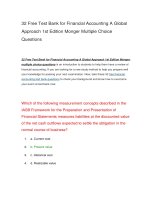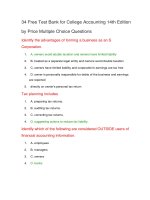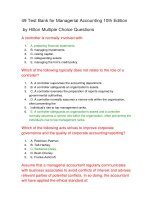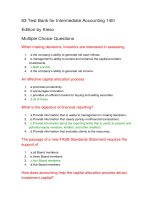59 free test bank for intermediate accounting 10th
Bạn đang xem bản rút gọn của tài liệu. Xem và tải ngay bản đầy đủ của tài liệu tại đây (70.76 KB, 15 trang )
59 Free Test Bank for Intermediate Accounting 10th
Edition by Kieso
Multiple Choice Questions Which of the following does NOT support the use of Accounting
Standards for Private Enterprises (ASPE)?
1.
a) Private enterprises usually have less complex business models.
2.
b) Private enterprises that are “going public.”
3.
c) Private enterprises usually have fewer users.
4.
d) Private enterprises’ financial statement users tend to have first-hand
information.
Financial accounting can be broadly defined as the area of
accounting that prepares financial statements to be used
1.
a) by parties internal to the business enterprise only.
2.
b) by investors only.
3.
c) by parties both internal and external to the business enterprise.
4.
d) primarily by external users and Canada Revenue Agency.
Audited financial statements are prepared by
1.
a) auditors.
2.
b) financial analysts.
3.
c) Canada Revenue Agency.
4.
d) management.
In a rules-based approach (such as U.S. GAAP), compared to a
principles-based approach (such as Canadian GAAP),
1.
a) the body of knowledge is smaller.
2.
b) the importance of communicating the best information to users is
emphasized.
3.
c) since it is more prescriptive, it may be easier to defend how to account
for a particular item.
4.
d) companies frequently do not interpret the rules literally.
Which of the following statements is not consistent with the
practice of accounting?
1.
a) Accounting theory and practice have remained static since their
inception hundreds of years ago.
2.
b) The responsibility placed on the accounting profession is greater today
than ever before.
3.
c) Accounting is largely a product of its environment.
4.
d) Accounting has three essential characteristics.
As of 2011, the responsibilities of the Accounting Standards
Board (AcSB) in Canada relate to setting standards for
1.
a) publicly accountable entities only.
2.
b) both publicly accountable entities and private enterprises.
3.
c) private enterprises, not-for-profit entities and pension plans.
4.
d) not-for-profit entities and pension plans only.
Which of the following is/are major factors in the rapidly changing
financial reporting environment in Canada?
1.
a) increased demand for accountants and the impact of technology
2.
b) globalization and the unethical actions of accountants
3.
4.
c) the growing number of institutional investors who want more information
regarding environmental and social issues
d) increased use of the Internet
Stakeholders who help in the efficient allocation of resources
include
1.
a) investors and creditors.
2.
b) financial analysts and regulators.
3.
c) creditors and auditors.
4.
d) management and auditors.
The essential characteristic(s) of accounting is (are)
1.
a) communication of financial information to interested internal parties only.
2.
b) communication of economic information to external parties.
3.
c) identification and measurement of financial information only.
4.
d) identification, measurement, and communication of financial information.
The term GAAP means:
1.
a) generally accepted accounting practices.
2.
b) generally accepted accounting principles.
3.
c) generally accepted auditing practices.
4.
d) generally accepted accounting purposes.
The adoption of International Financial Reporting Standards in
Canada is an example of
1.
a) the impact of technology on user's needs.
2.
b) the impact of globalization on capital markets.
3.
c) ethical behaviour.
4.
d) the desire of most private companies to expand internationally.
The “efficient markets hypothesis” proposes that
1.
a) market prices reflect information known only to internal stakeholders.
2.
b) market prices reflect all information about a company.
3.
c) market prices reflect information known only to external stakeholders.
4.
d) information asymmetry is required.
Which of the following is correct?
1.
a) Reported accounting numbers do not affect the transfer of resources.
2.
b) Credit rating agencies use accounting information to assess their assets.
3.
c) Efficient capital markets promote productivity and encourage innovation.
4.
d) Efficient capital markets promote productivity but do not encourage
innovation.
Which of the following statements does NOT describe the
activities and authority of the Ontario Securities Commission
(OSC)?
1.
a) The OSC reviews and monitors the financial statements of companies
whose shares are listed on the Toronto Stock Exchange
2.
b) The OSC issues its own disclosure requirements for listed companies.
3.
c) The OSC has the ability to fine or delist companies.
4.
d) The OSC issues financial accounting standards for Canadian
companies.
Management accounting can be broadly defined as the area of
accounting that communicates financial information
1.
a) to investors only.
2.
b) to parties internal to the business enterprise only.
3.
c) to parties both internal and external to the business enterprise.
4.
d) primarily to external users and Canada Revenue Agency.
Where information asymmetry exists, the capital market may
attract the wrong kind of company. This is known as
1.
a) moral hazard.
2.
b) conservative accounting.
3.
c) adverse selection.
4.
d) an inefficient marketplace.
Under ASPE, the primary sources of GAAP include
1.
a) accounting textbooks and journals.
2.
b) International Financial Reporting Standards.
3.
c) the CICA Handbook and appendices.
4.
d) research studies.
Which of the following statements accurately describes the
accounting profession’s role in the capital allocation process?
1.
a) Accounting rules are set by banks and other lending institutions which
provide capital.
2.
b) Company performance is measured by accountants and communicated
to investors.
3.
c) Only public companies are affected by the capital allocation process.
4.
d) The capital allocation process is regulated by the Financial Accounting
Standards Board (FASB).
In the United States, the body that has the final authority over
accounting standards is the
1.
a) Financial Accounting Standards Board (FASB).
2.
b) International Accounting Standards Board (IASB).
3.
c) Securities Exchange Commission (SEC).
4.
d) Accounting Standards Oversight Council (AcSOC).
Which of the following does NOT describe a cause of
management bias?
1.
a) the need to comply with contracts, such as debt covenants
2.
b) the desire to meet financial analysts’ expectations
3.
c) the tendency to downplay negative events
4.
d) the desire for all stakeholders to have access to all information
In Canada, the body that has the responsibility of overseeing the
Accounting Standards Board (AcSB) is the
1.
a) Accounting Standards Oversight Council (AcSOC).
2.
b) International Accounting Standards Board (IASB).
3.
c) Canadian Institute of Chartered Accountants (CICA).
4.
d) Financial Accounting Standards Board (FASB).
The exercise of professional judgement does NOT involve
1.
a) the use of knowledge gained through education.
2.
b) the application of knowledge gained through experience.
3.
c) the use of ethical decision making.
4.
d) aggressive accounting.
The preparation by some companies of biased information is
sometimes referred to as
1.
a) conservative financial reporting.
2.
b) full disclosure of all material facts.
3.
c) aggressive financial reporting.
4.
d) stewardship.
The widely publicized subprime lending crisis was NOT caused
by
1.
a) capital market participants who acted in their own self-interest.
2.
b) a lack of transparency.
3.
c) the practice of securitizing assets.
4.
d) a lack of investor understanding of the investment's true risk.
Financial accounting and managerial accounting have which
common characteristic?
1.
2.
a) Both culminate in the preparation of financial statements.
b) Both focus on preparation of information for use by internal and external
stakeholders.
3.
c) Both are concerned with communication of financial information.
4.
d) Both require financial information prepared in accordance with GAAP.
In Canada, the body which is NOT instrumental in the
development of financial reporting standards is the
1.
a) Accounting Standards Board (AcSB).
2.
b) Financial Accounting Standards Board (FASB).
3.
c) International Accounting Standards Board (IASB).
4.
d) American Institute of Certified Public Accountants.
The problem of information asymmetry can be reduced by
1.
a) aggressive accounting.
2.
b) accounting standards.
3.
c) adverse selection.
4.
d) only focusing on positive events.
The auditor’s primary responsibility is to
1.
a) review financial statements and discuss them with management.
2.
b) prepare financial statements.
3.
c) report to Canada Revenue Agency.
4.
d) report to standard setters.
The Sarbanes-Oxley Act (SOX) was NOT enacted to
1.
a) help prevent fraud and poor financial reporting practices.
2.
b) ensure the act was applied internationally.
3.
c) enable the SEC to increase its policing efforts.
4.
d) introduce new independence rules for auditors.
The financial statements most frequently provided include all of
the following except the:
1.
a) balance sheet.
2.
b) cash flow statement
3.
c) statement of surplus.
4.
d) income statement.
Which of the following does NOT describe a step in the IASB’s
standard setting process?
1.
a) appointing trustees to the IFRS Foundation
2.
b) development of an Exposure Draft
3.
c) provision of strategic advice by the IFRS Advisory Council
4.
d) public consultation
Which of the following is likely to be an advantage of the
advancement of technology on financial reporting?
1.
a) Users of financial information will have access to more information.
2.
b) The quality and reliability of the information may be compromised.
3.
c) Equal and fair access may be at issue.
4.
d) Internet reporting will increase costs.
Objectives of financial reporting do NOT include
1.
2.
a) providing information that is useful to users in making resource allocation
decisions.
b) providing information about the liquidation value of an enterprise.
3.
c) providing information about an entity’s economic resources, obligations,
and equity/net assets.
4.
d) providing information about changes in an entity’s economic resources,
obligations, and equity/net assets.
Whether a business is successful and thrives is determined by
1.
a) free enterprise or competition.
2.
b) competition and markets only.
3.
c) markets and competition only.
4.
d) markets, competition and free enterprise.
Financial accounting is concerned with the process that
culminates in
1.
a) the preparation of financial reports.
2.
b) specialized reports for inventory management and control.
3.
c) specialized reports for income tax calculation and recognition.
4.
d) reports on changes in stock prices and future estimates of market
position.
59 Free Test Bank for Intermediate Accounting 10th
Canadian Edition by Kieso Multiple Choice Questions Page 2
International Financial Reporting Standards (IFRSs) are issued by
the:
1.
a) FASB
2.
b) IASB
3.
c) SEC
4.
d) EU
International accounting standards are established by the:
1.
a) FASB.
2.
b) IASB.
3.
c) IASC.
4.
d) CICA.
Primary sources of GAAP for Canadian private companies do not
include the following:
1.
a) Handbook Sections 1400 to 3870
2.
b) Accounting guidelines
3.
c) Appendices to Handbook Sections 1400 to 3870 and Accounting
guidelines
4.
d) Pronouncements by accounting standard-setting bodies in other
jurisdictions
Accounting principles are "generally accepted" only when
1.
a) an authoritative accounting rule-making body has established it in an
official pronouncement.
2.
b) it has been accepted as appropriate because of its universal application.
3.
c) both a and b.
4.
d) neither a nor b.
Which of the following is a disadvantage of a “rules-based”
approach to standard-setting?
1.
2.
a) The body of knowledge is significantly larger than in a “principles-based”
system.
b) There is a tendency to literal interpretation of rules.
3.
c) There is less reliance on a conceptual framework, making it difficult to
interpret unusual situations.
4.
d) All of the above (all of the above could be considered disadvantages of a
“rules-based” approach).
The most authoritative primary source of GAAP for private
companies in Canada is:
1.
a) Accounting guidelines.
2.
b) industry practices.
3.
c) CICA Handbook recommendations.
4.
d) professional judgement.
The role of provincial securities commissions in Canada in
relation to financial reporting is to:
1.
a) ensure that investors have access to the information they need to make
informed decisions.
2.
b) make recommendations for financial accounting standards.
3.
c) form professional judgements regarding overall adherence to GAAP.
4.
d) develop standards for financial reporting by publicly traded companies.
All of the following are objectives of financial reporting except to
provide information:
1.
a) about entity resources, claims to those resources, and changes to them.
2.
b) that is useful in capital allocation decisions.
3.
c) about the major shareholders of an entity.
4.
d) that is useful in assessing management stewardship.
By virtue of the Canadian Business Corporations Act, which
organization has primary responsibility for setting GAAP for
private companies in Canada?
1.
a) Accounting Standards Board
2.
b) Accounting Standards Oversight Council
3.
c) Canadian Public Accountability Board
4.
d) Financial Accounting Standards Board
Standards and interpretations are issued by the:
1.
a) IASB.
2.
b) FASB.
3.
c) AcSB.
4.
d) All of the above.
Which of the following is true of the Accounting Standards
Oversight Council (AcSOC)?
1.
a) It oversees the activities of the Accounting Standards Board (AcSB)
2.
b) It is responsible for financial reporting standard-setting in Canada.
3.
c) It is made up entirely of accountants.
4.
d) Its purpose is to expedite the transition of Canadian public companies to
IFRS.
Which of the following stakeholders do not typically rely on the
financial statements to make resource allocation decisions?
1.
a) Investors
2.
b) Creditors
3.
c) Analysts
4.
d) Standard-setters
Challenges facing the financial reporting environment include:
1.
2.
a) Allowing stakeholders to have a voice in standard setting while ensuring
that political pressures do not influence the standard setting process to an
excessive extent.
b) Changes in technology.
3.
c) Ensuring the level of government oversight is appropriate – i.e; how
regulated should the financial reporting environment be?
4.
d) All of the above (all of the above pose challenges for the financial
reporting environment)
Which of the following is not true of a principles-based standardsetting system?
1.
a) Recognition that there cannot be a rule for every situation
2.
b) Significantly more detailed guidance than for a rules-based system
3.
c) A conceptual framework underlying the standards
4.
d) Heavy reliance on professional judgement
In order to ensure that funding for standards setting does not
result in politicization of standard setting, the IASB has committed
to four principles related to funding. Which of the following is not
one of these principles?
1.
a) Funding should be broad-based.
2.
b) Funding should be compelling.
3.
c) Funding should be open-ended.
4.
d) Funding should not be country-specific.
Which of the following is true of “professional judgement”?
1.
a) It plays an especially important role in ASPE and IFRS.
2.
b) It is important where standards are based primarily on general principles
rather than specific rules.
3.
c) It is used in conjunction with the conceptual framework in the absence of
specific standards.
4.
d) All of the above (all of the above are true in relation to “professional
judgement”).
The information provided by financial reporting pertains to
1.
a) individual business enterprises, rather than to industries or an economy
as a whole or to members of society as consumers.
2.
b) business industries, rather than to individual enterprises or an economy
as a whole or to members of society as consumers.
3.
c) individual business enterprises, industries, and an economy as a whole,
rather than to members of society as consumers.
4.
d) an economy as a whole and to members of society as consumers, rather
than to individual enterprises or industries.
Major corporate scandals in the early 2000s have resulted in all of
the following except:
1.
a) more emphasis on self-regulation of the accounting profession.
2.
b) more emphasis on internal controls.
3.
c) more emphasis on auditor independence.
4.
d) more emphasis on CEO and CFO accountability.
Accrual accounting is used because
1.
a) cash flows are considered less important.
2.
b) it provides a better indication of ability to generate cash flows than the
cash basis.
3.
c) it recognizes revenues when cash is received and expenses when cash
is paid.
4.
d) none of the above.
International GAAP is formally known as:
1.
a) International Accounting Standards
2.
b) International Financial Reporting Standards
3.
c) International Exchange Standards
4.
d) International Public Accounting Standards
Which one of the following organizations has not been a major
influence in setting of financial reporting standards for Canadian
entities?
1.
a) FASB (Financial Accounting Standards Board)
2.
b) AcSB (Accounting Standards Board)
3.
c) CRA (Canada Revenue Agency)
4.
d) IASB (International Accounting Standards Board)
Potential causes of management bias include all of the following
except:
1.
a) Financial statement users must exercise significant professional
judgement in interpretation of financial information.
2.
b) Financial statements provide information to users about management
stewardship.
3.
c) Managers are often compensated based on the company’s net income
or share value.
4.
d) Many lending agreements and contracts require that certain financial
benchmarks must be met.
The objective of general purpose financial reporting adopts an
entity perspective, which means that
1.
a) financial reporting should be focused an assessing the company’s
stewardship.
2.
b) financial reporting should be focused solely on the needs of the owners.
3.
c) companies are viewed as separate and distinct from their owners.
4.
d) none of these.
The Sarbanes Oxley Act does all of the following except:
1.
a) requires codes of ethics for senior financial officers.
2.
b) transfers the final authority for GAAP to the audit committee.
3.
c) strengthens independence rules for auditors.
4.
d) requires independence and financial expertise for members of the audit
committee.









